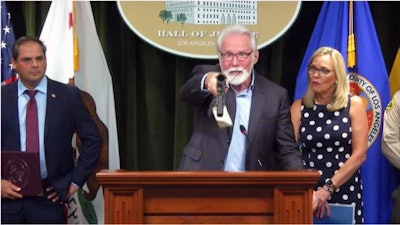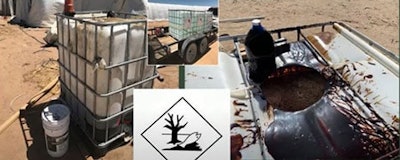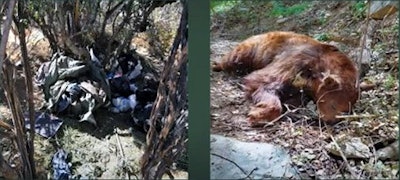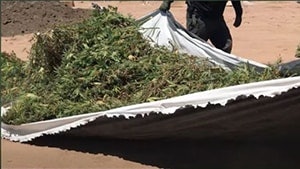

More than 400 law enforcement personnel from city, county, state and federal agencies seized $1.2 billion of illegal cannabis harvests and plants in Southern California during a 10-day eradication operation resulting in 131 arrests last month.
Despite exhausting human and financial resources during the operation, Los Angeles County Sheriff Alex Villanueva is still calling the largest operation in his department’s history part of an ongoing whack-a-mole game because more than half of the illicit cultivation practices on his team’s radar remain operational in the Antelope Valley of the High Desert, he said.
“The beauty of it is, they can’t hide,” he said in a press conference held July 7. “We see them. We’re going to come after them. It’s hard work. But with the resources, we’re going to get to all 100 percent of them. We got about 40 percent of them we addressed. We’ve got 60 percent to go.”
Operation personnel served search warrants at 205 locations. In the weeks leading up to the operation, investigators conducted reconnaissance flights and surveyed approximately 70% of all the available lands in the Antelope Valley—a region in northern LA County and the southeastern portion of Kern County, which constitutes the western tip of the Mojave Desert. During their flights, the investigators identified more than 500 illegal cannabis grows in LA County, Villanueva said.

The majority of those arrested were undocumented persons, Villanueva said. Many of the illegal grows have been directly tied to Mexican drug trafficking organizations as well as Asian and Armenian organized crime groups, he said.

“What we want to do is send a clear and loud message to the cartels and anyone doing an illegal operation in the high desert,” Villanueva said. “Your days are over and we’re coming for you.”
While investigators said they identified more than 500 illegal outdoor cannabis grows in LA County, Villanueva said there are as many as 860 illegal grows in neighboring San Bernardino County to the east, while Kern County to the north, Riverside County to the southeast and Ventura County to the west are also experiencing illegal operations.
“Well, this is a whack-a-mole game,” the sheriff said. “[San Bernardino County has] a lot less resources in terms of personnel than we do, so this is at least, on the grow side, this is a five-county problem that we need to resolve, and it’s going to take manpower. We have the ability, the willingness, the technical know-how, the expertise—what we’re always short on is the resources to get the people employed.”
Sheriffs’ department members from Kern, Riverside, San Bernardino and Ventura counties were among the 400-plus personnel involved in the LA County operation. Also collaborating on the operation were deputies from the Community Partnerships Bureau; Safe Street and Special Victims Bureau detectives; cities of Lancaster and Palmdale station deputies; Drug Enforcement Administration (DEA) agents; the California National Guard; and California Department of Fish and Wildlife agents. Water theft enforcement teams made 19 additional arrests.
Environmental Impacts

Water theft continues to threaten the water supply for residents in the eastern portion of the Antelope Valley, leaving many of the region’s potato, alfalfa and carrot farmers without a necessary resource, Villanueva said. The theft occurs from fire hydrants and unpermitted water wells that were being drilled on the grow sites.
“Most Californians would be shocked and disappointed at the amount of water these unlicensed, illegal grows are using, especially as California suffers from a drought,” DEA Associate Special Agent in Charge Curt Fallin said in the LA County Sheriff’s Department press release. “By our calculation, the illegal grows in Los Angeles, Riverside and San Bernardino counties require an astounding 5.4 million gallons of water a day, every day.”
On July 8, Gov. Gavin Newsom asked Californians to voluntarily cut back on household water consumption by 15% compared with last year, as he expanded his regional drought state of emergency to apply to 50 counties, or roughly 42% of the state’s population, Los Angeles Times reported.
The water theft by illegal cannabis growers is part of an effort to irrigate each plant up to 3 gallons of water per day in the High Desert, according to Eric Lindberg, the senior engineering geologist and chief of the South Coast Cannabis Regulatory Unit, who represented the Los Angeles Regional Water Quality Control Board during the July 7 press conference.

Unregulated cannabis cultivation operations often allow fertilizers, pesticides, petroleum fuels, sediment, irrigation tailwater, trash and human waste to be released into the environment and to pollute waters of the state, Lindberg said. And illegal diversions of surface water for cultivation drains lakes and streams, he said.
“In many cases, illegal pesticides are found at illicit cannabis cultivation sites,” Lindberg said. “Many of these pesticides are banned for use in the United States because they’re highly toxic to humans and animals. Illegal pesticides can contaminate the soil, service water and ground water, and are easily mobilized by stormwater runoff.
“Pesticides used to exterminate insects, rodents, mold and weeds can move up the food chain and can cause secondary poising and mortality of pets and other animals. These pesticides can also contaminate our drinking water supplies.”
Threat to Wildlife

During the 10-day operation, enforcement personnel also rescued 180 animals, including 84 dogs, many of which are up for adoption.
In addition, two dead bears were discovered nearby the illegal grow sites. Their deaths we directly attributed to pesticide use, according to the sheriff’s release.
Chloe Hakim, a biologist for the Department of Fish and Wildlife Region 5, as well as the lead scientist for the Los Angeles County regional department, said during the press conference that both scientific and enforcement action are needed to stop illegal grows and to mitigate their negative impacts.

Focused on protecting the diverse plant, fish and wildlife resources for their ecological value, and the habitat they depend upon, Hakim said seeing first-hand what the illegal grow sites have done to surrounding habitats has been tragic. During her field assessments, Hakim said she observed substantial alterations to streams from sediment buildups attributed to illegal cultivations through grading that can cause death and abnormalities to aquatic species, as well as stream crossing that cause fish impediment and other harms to nearby plants and wildlife.
Trash, illegal pesticides and illegal fertilizers also do harm, she said.
“Just a quarter teaspoon of carbofuran, which is an illegal pesticide that some illegal growers use, can kill a bear,” she said. “And you can only imagine what that can do to us humans when the sheriffs come across [it] and they’re picking out the weed, and biologists of our agency come across and they step by this pesticide. This is something that is important to resolve and important to get ahead and completely eradicate this kind of an issue.”
Some of the region’s critical species that need their habitats protected to thrive and survive include the Mohave ground squirrel, desert tortoise and Swainson’s hawk, as well as Joshua trees, which are protected under California state law, but illegal cultivators have cut them down to build their hoop houses.
Intimidating Local Residents

Not only are the illegal growers threatening wildlife and water supplies for local residents, but they’ve threatened and intimidated the locals themselves, U.S. Congressman Mike Garcia said during the press conference. Garcia represents California’s 25th District, which encompasses the majority of LA County’s northern region, including the cities of Lancaster and Palmdale.
“When I first heard about this problem at the beginning of this year, it was one of these things that you couldn’t believe it until you actually saw it,” he said. “I ended up going flying with the local sheriffs out in Palmdale in April. I saw it from the air at the time. There were roughly 400 to 500 of these illegal nurseries in the local area, and it was absolutely heartbreaking to see.”
After he landed, Garcia said he took a 25-minute drive to Pearblossom, an unincorporated community of roughly 2,500 people, where he held a townhall with local residents. The testimonies Garcia heard from those locals were absolutely tragic, he said. They were being threatened on a daily basis by bad actors and cartel members with weapons, he said.
“While I was at this townhall, we had a member of the cartel, an armed member of the cartel, in the front row,” Garcia said. “He was there to send a clear message, not to me, but to the residents that talking to elected officials about this problem was a bad idea. He was there to intimidate.”

Before last month’s operation, the illegal growers in the Antelope Valley faced zero risk and a substantial reward of up to $15 billion harvested from the High Desert on an annual basis, Garcia said.
While the sting operation resulted in the seizure of harvested cannabis and plants worth roughly $1.2 billion, investigators said that the operation accounted for only 40% of the illegal outdoor grows in the county, where up to four harvests per year can materialize. If those illicit grows went uninterrupted by law enforcement, LA County alone would have shadowed the state-legal market, which brought in $4.4 billion of retail sales in 2020.
“After this operation, we were able to rebalance the risk-versus-reward matrix, and we need to continue to make sure that the risks are unlimited and the reward is absolutely zero for these cartel members,” Garcia said.
Continued efforts are all about reclaiming the county for the residents of the Antelope Valley, Villanueva said.
Founded in 1850, the LA County Sheriff’s Department was the first professional police force in the Los Angeles area and worked to tame the lawlessness of the county over 150 years ago, he said. The department shouldn’t have to try and re-tame it again to regain a sense of law and order for a civil society, he said, but that’s what it’s had to do.

When Lancaster Mayor Rex Parris took the podium during the press conference, he picked up one of the 33 confiscated firearms from a nearby display table and pointed it in the direction of media members.
“This is the cartels,” he said. “We are very, very close to driving down the freeway and seeing bodies hanging from the overpasses. That is what’s coming. And if you have any doubt, our citizens have to look at this part of the gun; not this part.”
Parris set the gun back down on the table and said the cartel members are even walking into people’s homes to intimidate them.
Later in his remarks, Parris lightened the tone when talking about Lancaster lending its tractors and construction equipment that were used to tear down the illegal cultivation sites. “I got to ride one; it was great fun,” he said.
Continuing Efforts

Although many of the 131 individuals arrested were armed, Villanueva said they showed little resistance. Before the operation, the illegal farmers’ biggest threat was actually being ripped off by other cartels stealing their harvests, he said.
“We didn’t meet any really resistance at all, because typically when we showed up at one of the grows, everyone just took off into the desert running or they surrendered,” Villanueva said. “We didn’t get a lot of resistance.
“No one got away, for the record. Every single person that we put our eyes on is in custody.”
The 22 felony and 109 misdemeanor arrests have been filed with LA County District Attorney George Gascón’s office for consideration, Villanueva said. However, the sheriff did not offer overwhelming faith in the DA’s office.
“We have been very disheartened by the district attorney not filing on our cases for human trafficking when it comes to sex crimes and prostitution,” Villanueva said. “So now we’re going to present this and see what the district attorney will do, but hopefully he’ll do the right thing.”
With the district attorney’s decision out of his hands, Villanueva said his department will focus on eradicating the other 300-some sites investigators identified during their aerial reconnaissance. Last month’s operation cost about $1 million, he said. During the second week of the operation, his department had to scrounge around to pay for the gasoline involved in the eradication efforts, he said.

To help future efforts, Supervisor Kathryn Barger, who represents the 5th District on the five-member LA County Board of Supervisors, said she’s going to provide the sheriff’s department discretionary funding through her district allocation.
Further funding from the county was blocked by the majority of the supervisors, Parris said. That’s why Lancaster’s city equipment was used 17 miles outside of its jurisdiction, he said.
Last month, Barger’s office allocated $100,000 to the operation, she said during the press conference. Beyond that, the eradication efforts need to be more than an episodic position, she said.
“I have told my colleagues it’s only a matter of time before it leaves the Antelope Valley and hits down below,” she said. “What began as water theft has exploded to become the infiltration of organized crime groups in the Antelope Valley who are operating internationally.
“This illegal activity is impacting the quality of life for residents and businesses, and if left unaddressed, will have long-lasting and devastating effects in the region.”
As the illicit market continues to thrive throughout California, the outdoor operations in the Antelope Valley are the LA County Sheriff’s Department's primarily focus because they are the most visible, Villanueva said.
Meanwhile, the cartels are gobbling up cash-only real estate transactions, sometimes buying up entire neighborhoods of residential homes, and gutting the interiors to convert them into indoor grows, he said.
“So, you can see them starting to shift their operations to indoors,” Villanueva said. “That’s the next logical step for these illegal cartels.”

























